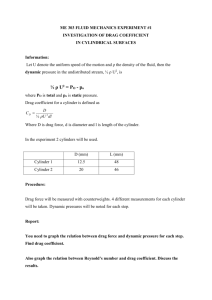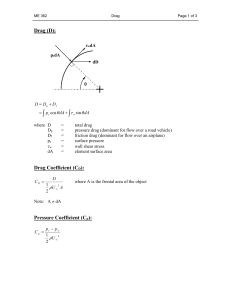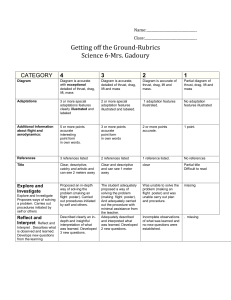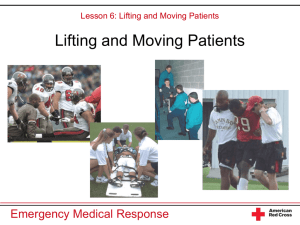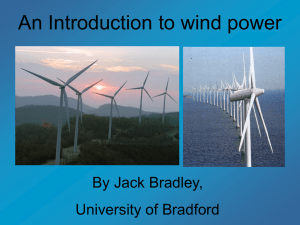Laboratory Simulations of Gravity-Driven Coastal Currents Small
advertisement
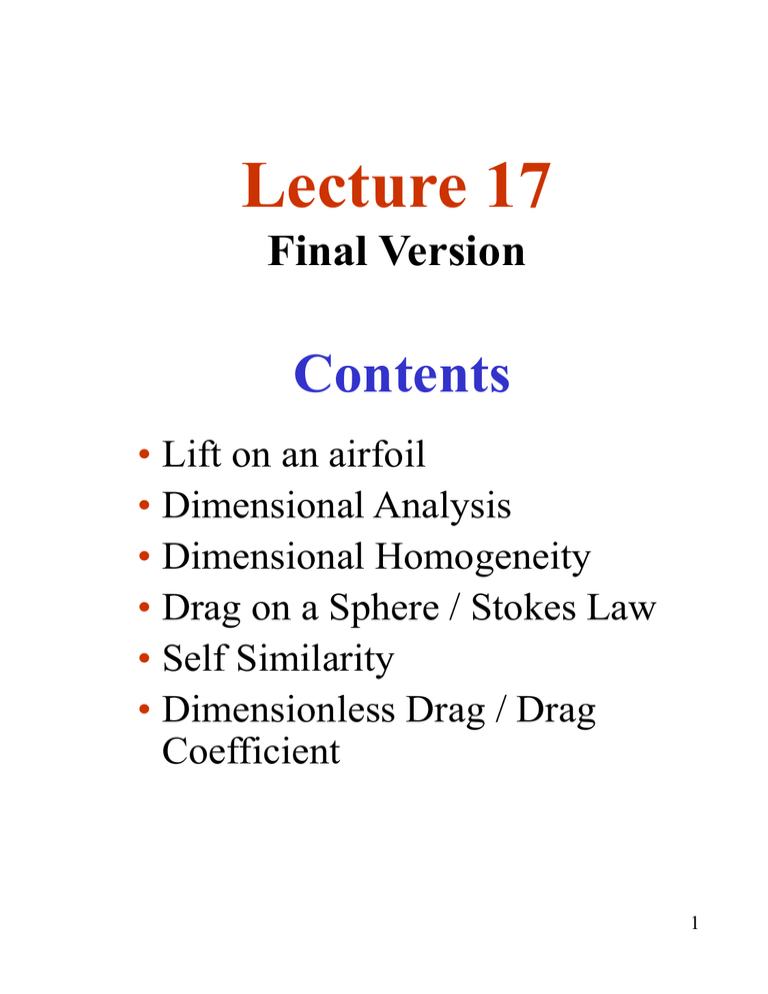
Lecture 17 Final Version Contents • Lift on an airfoil • Dimensional Analysis • Dimensional Homogeneity • Drag on a Sphere / Stokes Law • Self Similarity • Dimensionless Drag / Drag Coefficient 1 Recall : Cylinder with Circulation in a Uniform Flow • Without performing calculation, can see that a uniform flow around a fix cylinder gives no net lift or drag on cylinder since pressure distribution on surface is symmetric about x- and y-axis.. • In order to generate lift need to break symmetry. Achieved by introducing line vortex of strength, K, at origin which introduces circulation . G = 2p K • Note that this does not violate the flow around cylinder: line vortex produces a u component of velocity only. Hence, we are still adhering to condition that flow cannot pass through cylinder boundary. • Working from S.F. for cylinder in uniform flow additional inclusion of line vortex gives: r , U r sin sin K ln r C r Uniform flow Use result that radius R of resulting cylinder is : Line vortex Arbitrary at origin constant U And set : C K ln R R2 r U sin r K ln r R (1) Velocity Components Doublet at origin (1) ur 2 1 R U cos 1 2 r r uq = ¶y ¶r æ R2 ö K ç ÷ = - U¥ sin q ç1+ 2 ÷ + ÷ çè ÷ r ø r 2 Continued... • So, on surface (r=R), velocity components are: ur 0 u 2U sin • Surface Stagnation points also need: K R u 0 sin K 2 RU Note: By setting vortex strength zero (K=0), recover flow over cylinder in uniform flow with stagnation points at 0, • Plotting,… Choose value for K,… Now first get value of S.F. for r=R,... then set S.F. equal to that value,… then compile table r vs. angle… This gives particular streamline through stagnation points. Then choose any other point in flow field not on stagnation streamline,… determine value of S.F. for this point,… set S.F. equal to that value,… then compile table r vs. angle… This gives streamline through the chosen particular points… Then choose another point in flow field… etc (compare flow chart from beginning of lecture). For various values of K the following, flow fields emerge... K 0 K 1 K 2 K 3 3 Pressure Distribution Around the Cylinder • To evaluate press. on cyl. surface use Bernoulli Eq. along S.L. that originates far upstream where flow is undisturbed. Ignoring grav. forces: 1 1 2 p U 2 p U S S 2 2 On cylinder surface Upstream undisturbe d flow U2S = ur2 + u2q • Substituting for surface flow speed : uR = 0 , uq = - 2U¥ sin q + with K R … difference in pressures between surface and undisturbed free stream pS p 1 U 2 2 2 4 K K 2 sin 1 4 sin RU R U In particular for non-rotating cylinder where K=0: pS p Def.: Pressure 1 U 2 1 4 sin 2 2 Coefficient Cp pS p 1 4 sin 2 1 U 2 2 (1) (2) Only top half of cyl. shown. 4 Continued... Qualitative behaviour of 2 K pS p 4K 2 Cp 1 4 sin sin 1 R U R U 2 U 2 for various values of K RU . ( 0 : Rear of cyl. , 2 1.57 : Top of cyl., 3.14 : Front of cyl. , 3 2 4.71: Bott. of cyl. ) • Best way of interpreting above graphs is to think of flow velocity and radius being constant while vortex strength is increasing from one plot to next. • When plotting graphs I did not explicitly specify velocity or radius! I simply used different numeric values for K RU in order to illustrate behaviour of graph. I have not considered 5 if any of these cases may not be realizable in reality or not!. Continued... Equation (1) … pS p 1 U 2 2 2 4 K K 2 sin 1 4 sin R U R U … can be used to calculate net lift and drag acting on cylinder! Sketch (A) Sketch (B) • In Sketch (b) ... L p sin pS p sin D p cos pS p cos • Hence, integration around cylinder surface yields total L and D ... L 2 p 0 S p sin b R d D 2 p 0 S p cos b R d where b is width (into paper) of cylinder. Substituting for pressure using Eq. (1), and integrating (most terms drop out), leads to following results: 1 L U 2 2 4K b R R U 2 U K b Or, lift per unit width: D0 L U 2 K U b Thus, drag zero… a remarkable result! Kutta Joukowski Lift Theorem d' Alembert' s Paradox 6 Continued... • Net lift is indicated in sketch below. ... Note that if a line vortex is used which rotates in mathematically positive sense (anti-clockwise) then resulting lift is negative, i.e. downwards. U L U b L • Final notes: How is lift generated? ... From sketch above and from pressure profiles plotted earlier it is evident how this is physically achieved… Breaking of the flow symmetry in x-axis means that flow round lower part of cylinder is faster than round top - this means that pressure is lower round bottom and so a net downward force results. Notice that symmetry in y-axis is retained … symmetry of pressure on left-hand and right-hand faces is retained and so there is no net drag force. Keep in mind that our analysis was for an ideal fluid (i.e. there is no viscosity). In a real flow would fore-aft symmetry be retained? • Lastly, since lift is proportional to circulation, we wish to make circulation large to generate a large lifting force. In applications of above flow this is achieved by spinning cylinder to produce large vorticity… but is there a limit to how much circulation we should produce? ------------------------End of Recall-------------------- 7 Circulation and Lift for Aerofoil Applications • If a thin symmetric aerofoil is placed at zero incidence in an inviscid, irrotational and imcompressible uniform flow, the flow pattern shown in Fig. (1) below ensues. There is no circulation and the aerofoil does not generate lift. (This case is analogous to the cylinder with 0) Fig. (1) • In case of cylinder, can generate vorticity by spinning cylinder. For airfoil section this can be achieved by setting it at incidence or by using a non-symmetric shape (which shape to get lift? … and to get negative lift?). Placed at incidence, flow past a thin symmetric aerofoil is shown in Fig. (2). Fig. (2) Clearly airfoil experiences upward force - compare flow speeds on upper and lower surfaces. We have seen that this type of flow speed differential can be modelled by using line vortices which yield circulation and hence lift. (In Fig. (2) line vortices would have negative K to give clockwise velocity contribution.) 8 Continued... • If we wish to calculate lift per unit span on aerofoil section using Kutta-Joukowski Lift Theorem ... L U b : Density Air U : Flow Speed : Circulation … then need to know value of circulation for a given aerofoil at a specific flow speed and for particular angle of incidence. Key to finding unique value of circulation lies in modelling flow at trailing edge of aerofoil. Consider Fig. (3a-c) below ... Fig. (3) Evidently the correct value Kutta has been used in Fig. (3c). The KUTTA CONDITION ... … states that flow from upper and lower surfaces must leave trailing edge with same speed. The Kutta condition thus determines correct value of circulation when performing a calculation of flow around a lifting aerofoil. 9 Continued... • Increasing either : Angle of Incidence increases or U : Flow Speed Kutta and hence the lift. Is there a limit to how large one can make angle of incidence and hence Kutta ? • For a flat plate with incidence the lift experienced is L U cU b where c is length of plate. Non-dimensional lift coefficient given by L CL 2 1 U 2 b c 2 • This result (as with calculations for aerofoils) is achieved by using a line of vortices - a vortex sheet - ‘within’ aerofoil section to generate circulation, rather than a single line vortex as used for cylinders in our earlier considerations. 10 Continued... • Qualitative comparison of pressure coefficient for NACA 0012 airfoil at incidence with one of the earlier graphs for pressure coefficient of a rotating cylinder. (Comparison included here to highlight where corresponding points / regions are and to practice how to read such graphs.) NACA airfoil Upper wing surface Lower wing surface Upper cyl. half Rotating cylinder Lower cyl. half • Note: In order to get negative pressure coefficient on top half of cylinder and (i.e. upward lift) need to reverse sense of rotation of line vortex used in example for flow around rotating cylinder. 11 Dimensional Analysis and Model Testing •Introduction to Dimensional Analysis Consider drag D of sphere …. On what quantities does it depend? Diameter, d Flow Speed, V Fluid Density, Fluid Viscosity, Write D F d ,V , , (1) • Note: Eq.(1) reads … Drag, D, is a Function of ... What does the above mean in terms of the measurements we have to carry out to collect data for all possible spheres in all types of fluids? 12 Continued ... WE NEED ... 1 page for Drag as function of 2 variables (e.g. velocity and diameter) d increases from curve to curve 1 page for each value of 1 book for Drag as function of 3 variables (e.g. velocity, diameter, density) Shelf of books for Drag as a function of 4 variables (velocity, diameter, density, viscosity) If we want 10 data points per curve, at £10 each experiment, this will cost... 10 10 10 10 £10 £100,000 THERE MUST BE A BETTER WAY !?!? 13 Continued... DRAG GOAL IS TO COMPRESS SHELF OF BOOKS INTO ONE SINGLE GRAPH... 4 Independent Experimental Parameters How Could We Possibly Achieve This? 14 •Dimensional Analysis for Re<<1 (Note: Later we will relax this restriction and look at larger Re.) What does imposed restriction mean? Re 1 Rate of Change of Momentum Inertia Force i.e. 1 Viscous Force Viscous Force Inertia Forces Viscous Forces Viscous Forces are the dominant forces! • Inertia Forces are associated with density of Fluid • Consequently, if Inertia Forces << Visc. Forces then, to a good approximation DRAG DOES NOT DEPEND ON DENSITY of FLUID! Thus, Eq.(1)... D F d ,V , , (1) - repeated reduces to ... D F d ,V , (2) 15 Continued... So, we are restricted to flow with.. L A M I N A R LOW RE NUMBER Restrictions exclude ... T U R B U L E N T HIGH RE NUMBER 16 Continued... • The expression Eq.(2) ... D F d ,V , (2) - repeated … represents a VERY general statement!!! • CRUCIAL NEXT STEP: Ensure that function F has such a form that one ends up with same dimensions on both sides of equal sign. • Hence, we may NOT choose a function that produces a non-sense statement where units are for instance ... D d 2 V 3 1 Units: kg m s2 m3 kg kg m 4 4 Units: m 3 s sm s 2 • QUESTION: How Do I Have To Choose Exponents Such That Units AreThe Same on Both Sides Of Equation? 17 Continued... Answer question by determining conditions for exponents under which one gets same units on both sides of equation ... D F d ,V , (2) - repeated N Units: Dimensions: kg m s2 M L T 2 M : Mass m L m s L T 1 L : Length kg ms M L1 T 1 (3a-c) T : Time WANT !!! , , such that D V d (4) gives M L T 2 M L T 2 Find by subst. Eq.(3a-c) into Eq.(4) ... 18 Continued... D V d ML T 2 L T 1 L ML (4) - repeated 1 T 1 Collect corresponding terms ... M L T 2 M L T (5) By comparing exponents ... • … of M on left and right hand side of Eq.(5) 1 (6a) • … of L on left and right hand side of Eq.(5) 1 (6b) • … of T on left and right hand side of Eq.(5) 2 • Substitut Eq.(6a) into Eq.(6c) ... 2 1 1 (6c) (6d) • Substitut Eq.(6a) and Eq.(6d) into Eq.(6b) ... 1 1 1 1 19 Continued... • In summary we get... D V d (4) - repeated … where ... 1 1 1 •This is the ONLY possible solution for the three simultaneous linear equations Eqs.(6a-c)! •It is the ONLY possible solution that ensures ... DIMENSIONAL HOMOGENEITY This solution ... D const V d 3 is the ... for sphere. Must be obtained from experiments or theory STOKES’ LAW Recall, that it is only valid for low Re! 20 Continued... STOKES’ LAW Recall, that it is only valid for low Re! D const V d • While we assumed Re<<1 experiments show that Stokes law is, in fact, valid for Re<2. • For flow regime where Stokes law is valid drag is proportional to velocity. Hence, doubling velocity results in double drag. We will later see that this is not the case for higher Reynolds numbers. • The constant in Stokes law can, in principle be obtained from one single experiment. • Think about all this an ‘let it sink in’… We have determined formula for drag forces acting on sphere without knowing anything about the physics of the flow. The only thing we did was ensuring dimensional homogeneity! Of course the whole strategy can only yield correct results if we have identified all parameters involved in problem. 21 A note on …. Self Similarity • Recall that we used a function of type... D V d for the dimensional analysis. This is called a power-law relation. • A common view is that scaling or power-law relations are nothing more than the simplest approximations to the available experimental data, having no special advantages over other approximations. ... … IT IS NOT SO ! Scaling laws give evidence of a very deep property of the phenomena under consideration their ... … SELF SIMILARITY Such phenomena reproduce themselves, so to speak, in time and space. From: G.I. Barenblatt, Scaling, self-similarity, and intermediate asymptotics. Cambridge University Press, 1996 22 Continued... ‘Reproducing themselves’ means ... … that wake behind an inclined flat plate looks the same as flow ... … the wake of a grounded tankship. Power laws are ‘Magnifying Glasses’… Example: (I) Going from a 2 to gives 2a 2 4 a2 (II) Apart from scale factor 4 Eq.(II) is the same as Eq.(I) 23 Continued... Some Background Info: Classic example illustrating how powerful dimensional analysis can be ... Explosion of Atomic Bomb r t Ground Ground 100 m • By measuring radius r as a function of time, t, G.I. Taylor was able to deduce energy released when bomb explodes by means of dimensional analysis alone from analyzing freely available cine films of explosions. • The figure was considered ‘Top Secret’ back in the 1940s • Taylor’s result caused ‘much embarrassment in US government circles. G. I. Taylor 24 Continued... TIP: • Use requirement for dimensional homogeneity as a quick check for correctness of unfamiliar equations! Example • Someone claims that drag force, D, acting on sphere with diameter d moving with velocity V through a fluid of viscosity is given by ... D 3 V d 2 (Formula is wrong!) Use dimensional arguments to show that this formula cannot be right! Solution • Left-hand side of equation is: D is a force, hence, dimensions are [N]= ékg . m/s2 ù= M L êë úû T2 ([..] tells that you take the dimension of the unit) • Right-hand side of equation is: Velocity Diameter 2 Viscosity L T ´ 2 (L) ´ M LT = M L2 T2 Different dimensions on both sides of the equation. Hence, formula cannot be right! 25 Continued... Briefly recall where we were coming from and where we are heading for…. DRAG GOAL WAS… TO COMPRESS SHELF OF BOOKS WITH DRAG DATA INTO ONE SINGLE GRAPH... 4 Independent Experimental Parameters We are not there yet but we are getting closer... 26 Dimensionless Drag / Drag Coefficient p p Stagnation Point Flow ps , V 0 V V • Apply Bernoulli along streamline to stagnation point ... 2 2 (1) p V ps 2 ps p 2 V • Pressure in wake must be approximately equal to pressure in free stream pw p (2) • If one neglects viscosity then drag arises only because of different pressures on ‘front’ and back of sphere. With Eq. (2) p ps pw (3) p ps p (4) 27 Continued... • Pressure forces act on area approximately equal to CROSS-SECTIONAL AREA d A 2 • Since 2 d : Diameter PRESSURE= DRAG/AREA d Drag ps p 2 With Eq. (1) • Divide (5) Drag 2 V2 d 2 2 2 (6) through by right hand side and DEFINE the DRAG COEFFICIENT CD CD Drag 2 V2 d 2 2 • CD is a non-dimensional number • CD is a non-dimensional representation of the drag force 28 Continued... Notes: • Main assumption was to neglected viscosity. This means we are dealing with Reynolds numbers for which Stokes’ law is NOT applicable. Hence, we have considered high Reynolds numbers, i.e. Re>>1. Only for these an extended wake exists. • As right-hand and left-hand side approximately equal in Eq.(6) the drag coefficient must be of order 1 under the assumptions (Re>>1) we made. On previous page defined drag coefficient for a sphere. This definition can be extended to include bodies of arbitrary shape... General Definition of Drag (and Lift) Coefficient Drag CD Coefficient of Lift CL Drag or Lift 2 V2 Area Notes: • Carefully check exact definitions of quantities such as CD, CL or Re Before using data found in literature! Definitions may vary! • Usually one uses projected area (cross-sectional), i.e. area one sees when looking towards body from upstream for CD. But for CL for airfoils one uses one uses the planform area. 29

